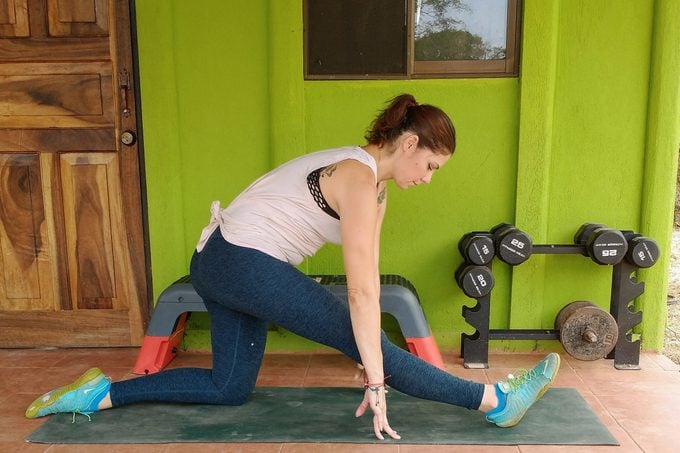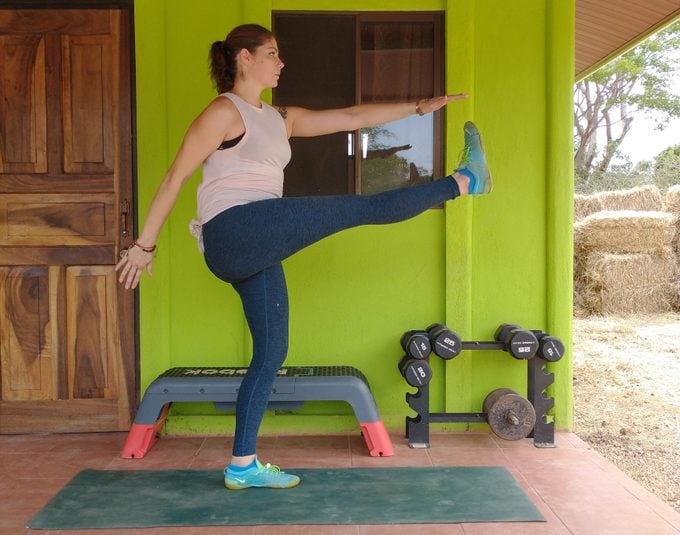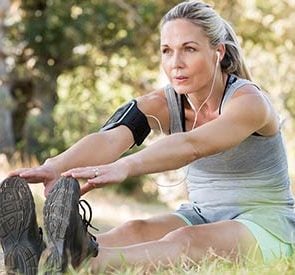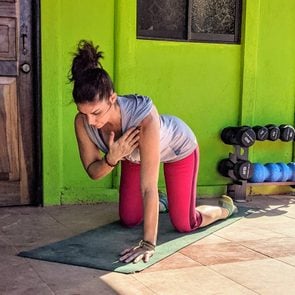Static vs. Dynamic Stretching: What’s the Difference?
Updated: Jun. 10, 2021
Learn when and how to include static and dynamic stretches to warm up, improve performance, enhance flexibility, and recover from a tough workout.
Stretching, flexibility, and mobility
Flexibility and mobility are important parts of living a long and healthy life. And stretching plays a major role. It improves the range of motion at each joint. That’s huge—poor range of motion can limit flexibility and ultimately interfere with a person’s ability to move.
It should come as no surprise that moving comfortably, whether you’re walking around the office or playing a game of pick-up basketball, can help you better enjoy life. Stretching techniques—along with general activity, foam rolling, and interventions in physical therapy, chiropractic, and even cognitive training—all offer an assist.
There’s no one-size-fits-all activity to best improve flexibility. The best stretching intervention for you will depend on a bunch of things, including your fitness level, lifestyle, age, injuries or illnesses, gender, and workout goals.
Research backs a wide range of helpful options. That said, two of the most accessible and widely researched methods for improving flexibility are static and dynamic stretching. Practically everyone can incorporate these simple approaches into their weekly routines without needing outside assistance. When used correctly, they can both help improve range of motion, flexibility, and mobility.
Before you launch into a pre-workout stretch, learn when and how to use static vs. dynamic stretching.
Types of stretching
There are four basic styles of stretching: static, dynamic, proprioceptive neuromuscular facilitation (PNF), and ballistic.
Ballistic stretching uses bouncing movement to push the body past its natural range of motion. It’s fallen out of favor because it’s less effective than other styles and may be more likely to result in injury.
PNF stretching aims to improve flexibility and range of motion, but it’s best performed with a trained partner, making it more difficult to perform at home.
That leaves the most widely-used forms of stretching: static and dynamic.
Both are easy to perform on your own, have research supporting their effectiveness, and are unlikely to lead to injury when done correctly. Thanks to their accessibility, safety, and effectiveness, they’re good stretching techniques for the average person to incorporate into their workout routine.
Static vs. dynamic stretching
The clear and obvious difference between the two forms of stretching is right there in the name. Static stretches are performed without movement. You simply hold a stretch and relax into it. Dynamic stretches are performed while moving.
This basic difference accounts for the specific benefits and outcomes of each type of stretch. So, yes, both styles of stretching can help you improve your flexibility and range of motion. But how you use each type will depend on your exercise goals.
(Check out these dynamic and static leg stretches.)
What is static stretching?
When you think of stretching, you probably imagine static stretching. It’s the traditional form of stretching that has long been used in physical education and sports, and it’s often added at the beginning or end of an exercise session.
“An example of a static stretch is a quadruped hamstring stretch,” says physical therapist Grayson Wickham, founder of Movement Vault. “You have your hands and back knee down on the mat while the leg you’re stretching is out in front of you. To increase the stretch, you push your hips back until you feel a maximal stretch in the back of your front leg. From here, you simply hold, relax, and breathe deeply.”
Other examples might include a forward fold (you know, bend and touch your toes), a standing quad stretch, or an overhead triceps stretch. Regardless of which stretch you perform, the marker of a static stretch is that you’re not moving the joint you’re stretching. You simply hold a position steady at the point of mild discomfort (but not pain!) and allow yourself to relax into it.
The American College of Sports Medicine (ACSM) suggests holding each stretch for between 15 and 30 seconds, repeating the hold for up to four sets.
When to include static stretching
Static stretching is an excellent form of flexibility training to include at the end of your workout routine or as a stand-alone program that you complete after warming up your muscles.
“One of your main goals with static stretching is to relax your entire body,” says Wickham. “This helps decrease your sympathetic nervous system response and muscle tone, helping you move deeper into the stretch.”
When performed regularly, you can see increases in range of motion at the muscles and joints you’re targeting.
(Try this full-body stretching routine that can be done statically or dynamically.)
When to avoid static stretching
For many years, static stretching was promoted as an injury-prevention tool to do before a workout. The idea was that if you stretched before a workout, you’d be less likely to pull a muscle during your routine.
In practice, that’s not the case, at least when it comes to static stretching. This is largely because static stretching doesn’t do anything to increase core body temperature or promote increased blood flow to the muscles you’re targeting.
You’re essentially stretching a cold muscle and joint. What you want to promote before a workout is active mobility, not static flexibility. That is, you need to warm up your working muscles and prepare them for the task at hand, not simply stand (or sit) and hold a stretch.
“When it comes to increasing and improving mobility, static stretching isn’t the most effective stretching technique to utilize,” says Wickham. “Static stretching has been shown to increase injury risk and decrease performance when performed before an athletic endeavor or workout.”
In other words, static stretching before a workout, like you used to do in elementary school gym class (and may still do out of habit), may actually be counterproductive to your goals.

What is dynamic stretching?
The terms dynamic stretching and dynamic warm-ups are often used interchangeably. And for good reason: dynamic stretching is best used at the beginning of a workout as a way to help you get warmed up and prepared for your routine.
And while dynamic stretching movements may not look like the stretching you’re used to, they’re intended to take you to the end of your natural range of motion and back again. They’re active moves that increase blood flow and prepare your muscles for work.
“An example of a dynamic stretch is performing straight-leg high-kicks,” says Wickham. “To perform this exercise, stand as tall as possible and kick one leg straight forward as high as possible while keeping your knee straight. With this stretch, you are contracting your hip flexor muscles and stretching out your hamstring muscles.”
How to do dynamic stretches
There are two key things to keep in mind about dynamic stretches. First, you’re moving to the end of your natural range of motion at a given joint without trying to push past it. The goal is to feel a light stretch of the muscles and joint you’re targeting without overstretching or overdoing it.
Second, the movement should always be controlled and shouldn’t use momentum. “Because dynamic stretching involves actively moving your body and joints, if you move too quickly through a large range of motion, you could cause a mild injury,” warns Wickham.
In the straight-leg high-kick example, you’re not swinging your leg forward and backward with force or using your torso or other muscles to propel your leg to Dallas Cowboy Cheerleader-level high kicks. Instead, you’re standing straight and tall, isolating the leg you’re stretching, and kicking steadily so the top and bottom of the kick are completely under your control.
Ultimately, you’d perform 10 to 20 kicks per side and move on to other dynamic stretches to target other muscles and joints. And you’d keep your intensity lower for the first few reps, slowly increasing the intensity as you go.
Dynamic stretches include regular athletic movements like squats, lunges, and push-ups that are performed at a lower intensity or without weight. They also include movement series, such as a yoga sun salutation or a transition from a plank to a standing position.
When performing dynamic stretches before a workout, it’s important to focus on stretching the muscles and joints you’ll be using during your workout to effectively prepare your body for work.

When to include dynamic stretching
“Dynamic stretching can be performed at any time and is especially effective when performed before an athletic endeavor or workout,” Wickham says. “Dynamic stretching improves your proprioception [body awareness], contracts specific muscles, and primes your nervous system for a sport, workout, or movement you’re about to perform.”
You can perform dynamic stretching for a certain number of repetitions or a certain length of time. You might do a dynamic exercise for 10 to 20 reps or for 20 to 40 seconds before progressing to the next movement.
Stretching for recovery
One of the other long-held beliefs about stretching is that it helps reduce muscle soreness after a workout while facilitating recovery.
To some degree, this is true. But it’s not because the act of stretching decreases soreness. Instead, stretching can encourage mobility and blood and oxygen flow to the muscles you worked. This in turn helps the body remove waste products and deliver nutrients for cell turnover and regeneration.
It’s not just stretching that facilitates recovery, though. If you’re looking to truly reduce the aftereffects of a tough workout, approach your entire routine with a mind for fast recovery. According to the ACSM, this means including a dynamic stretch before your workout, a cool-down and static stretch after your workout, and additional protocols like foam rolling, massage, cold therapy. Add to those the appropriate post-workout nutrition, hydration, and sleep.



